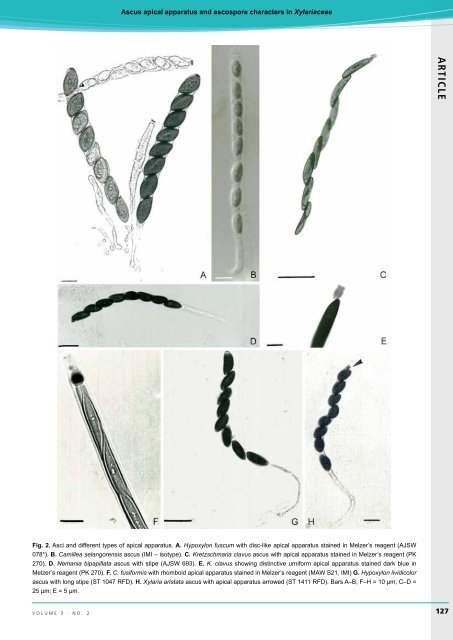AR TICLE Ascus apical apparatus and ascospore ... - IMA Fungus
AR TICLE Ascus apical apparatus and ascospore ... - IMA Fungus
AR TICLE Ascus apical apparatus and ascospore ... - IMA Fungus
You also want an ePaper? Increase the reach of your titles
YUMPU automatically turns print PDFs into web optimized ePapers that Google loves.
<strong>Ascus</strong> <strong>apical</strong> <strong>apparatus</strong> <strong>and</strong> <strong>ascospore</strong> characters in Xylariaceae<br />
<strong>AR</strong><strong>TICLE</strong><br />
Fig. 2. Asci <strong>and</strong> different types of <strong>apical</strong> <strong>apparatus</strong>. A. Hypoxylon fuscum with disc-like <strong>apical</strong> <strong>apparatus</strong> stained in Melzer’s reagent (AJSW<br />
078*). B. Camillea selangorensis ascus (IMI – isotype). C. Kretzschmaria clavus ascus with <strong>apical</strong> <strong>apparatus</strong> stained in Melzer’s reagent (PK<br />
270). D. Nemania bipapillata ascus with stipe (AJSW 693). E. K. clavus showing distinctive urniform <strong>apical</strong> <strong>apparatus</strong> stained dark blue in<br />
Melzer’s reagent (PK 270). F. C. fusiformis with rhomboid <strong>apical</strong> <strong>apparatus</strong> stained in Melzer’s reagent (MAW S21, IMI) G. Hypoxylon lividicolor<br />
ascus with long stipe (ST 1047 RFD). H. Xylaria aristata ascus with <strong>apical</strong> <strong>apparatus</strong> arrowed (ST 1411 RFD). Bars A–B, F–H = 10 µm; C–D =<br />
25 µm; E = 5 µm.<br />
volume 3 · no. 2<br />
127
















